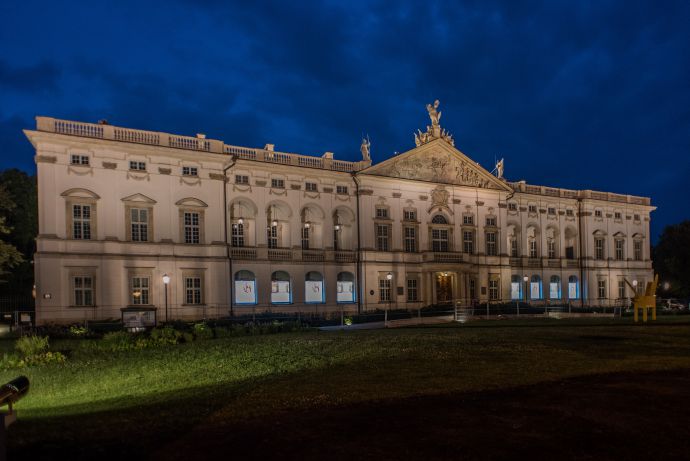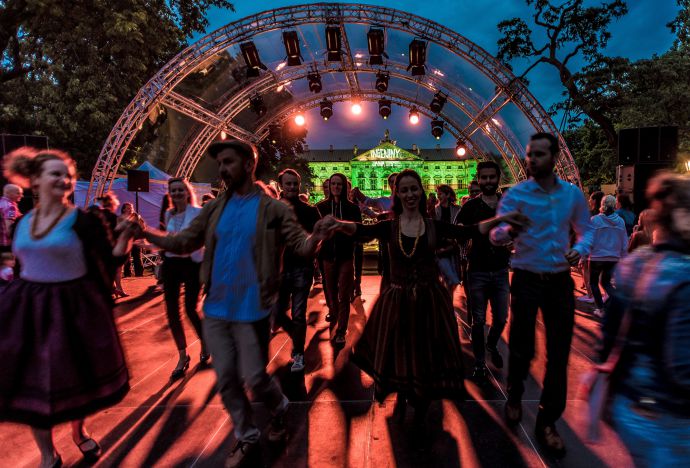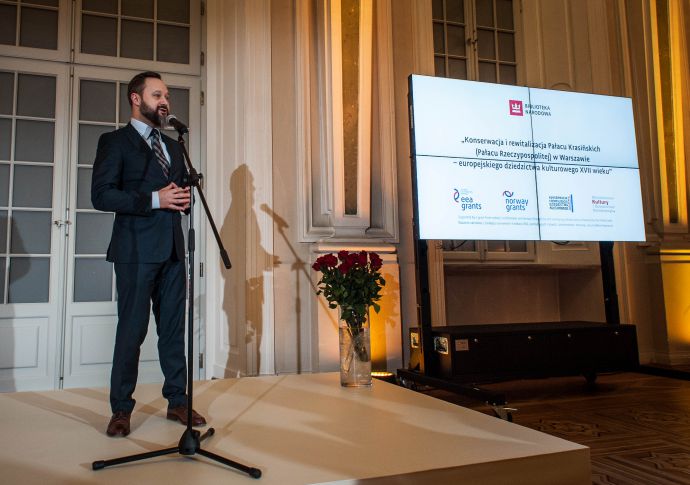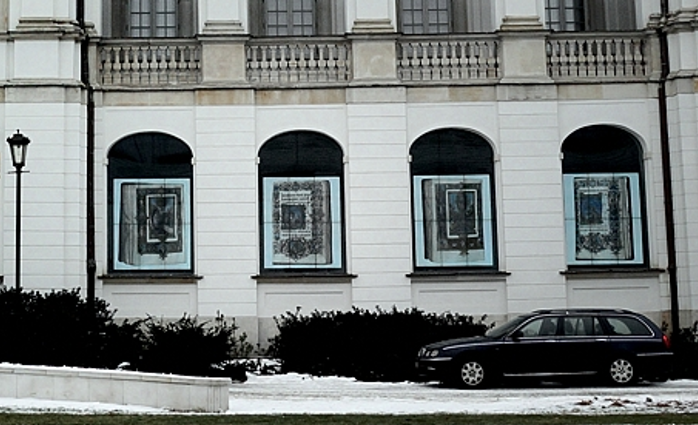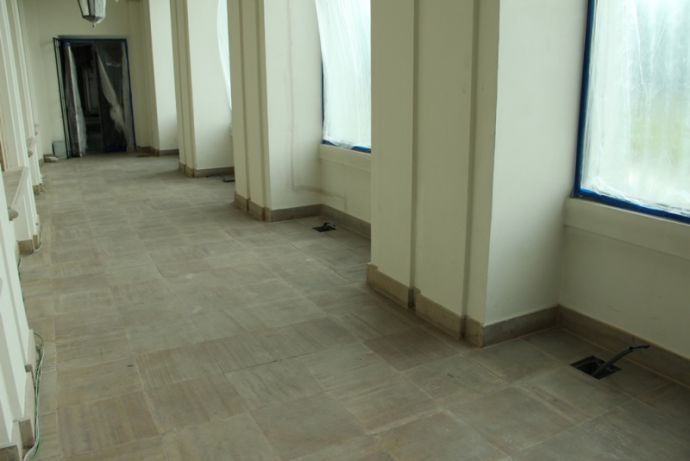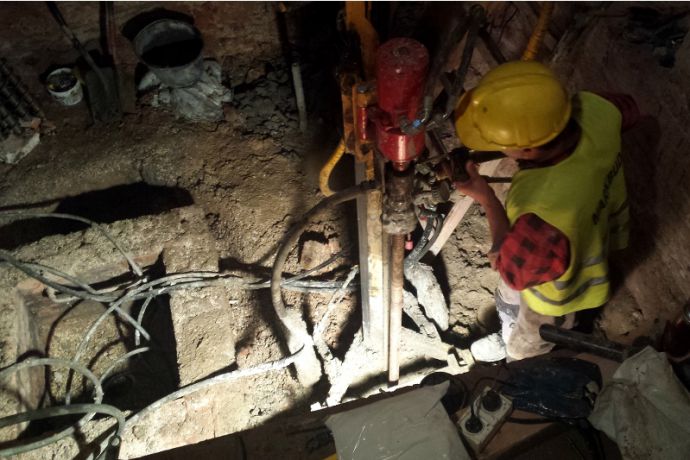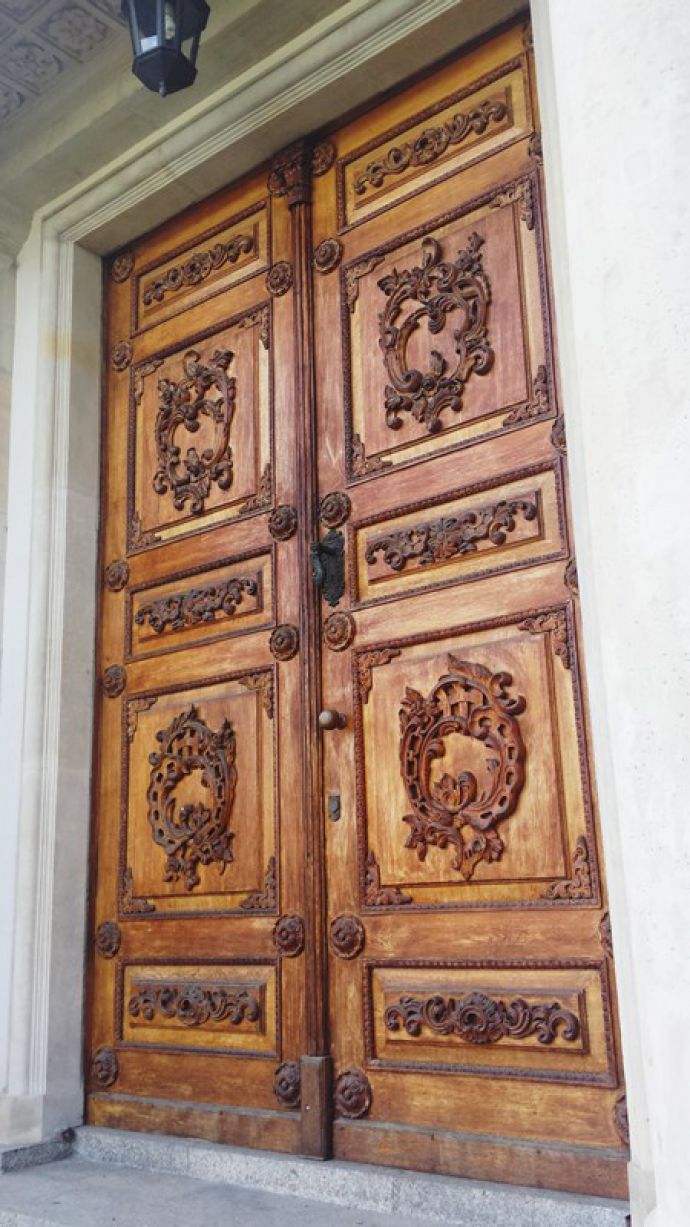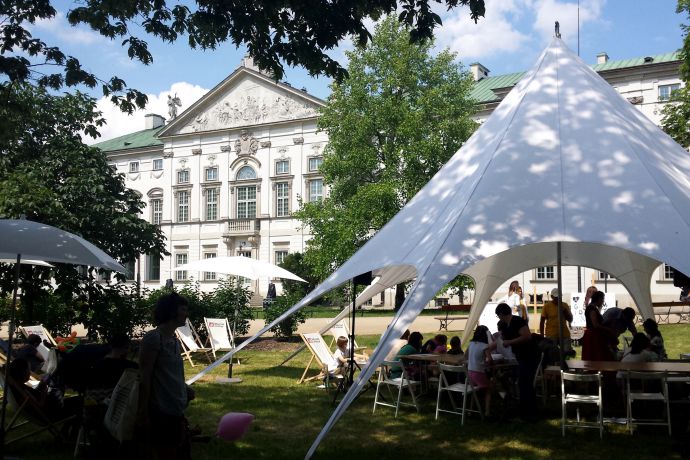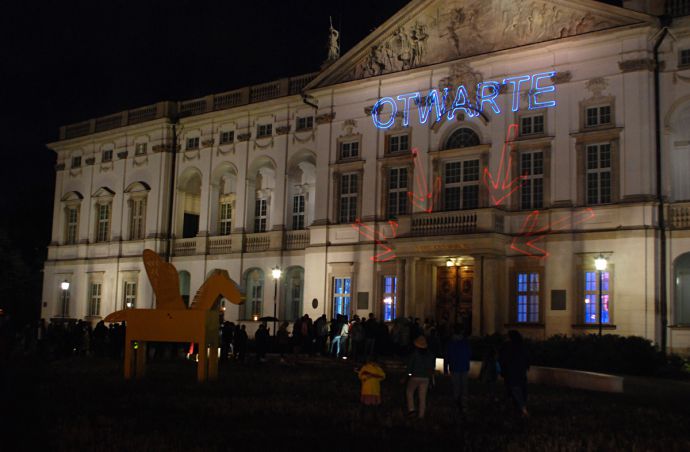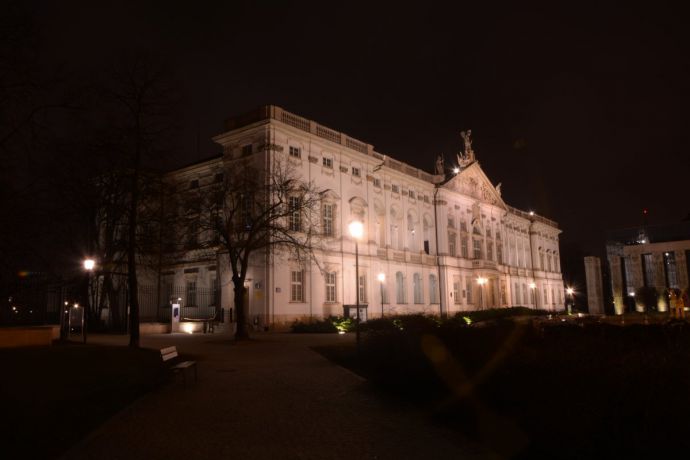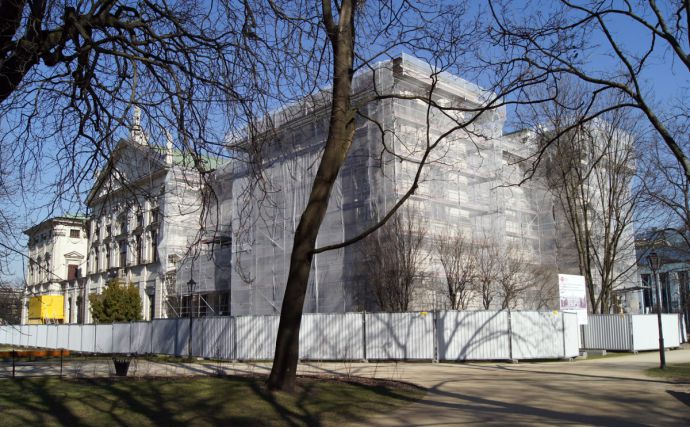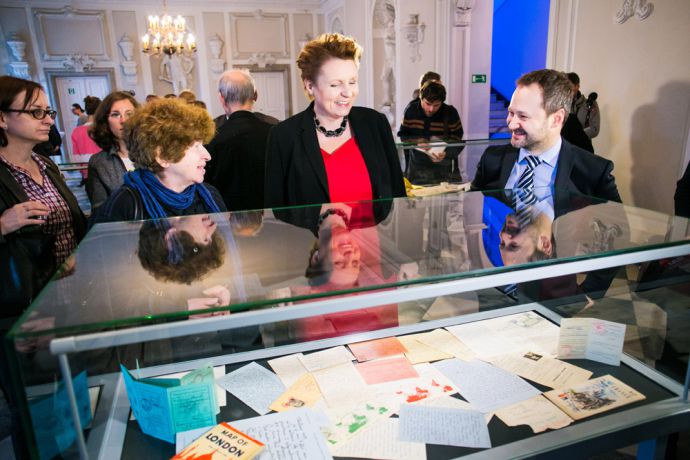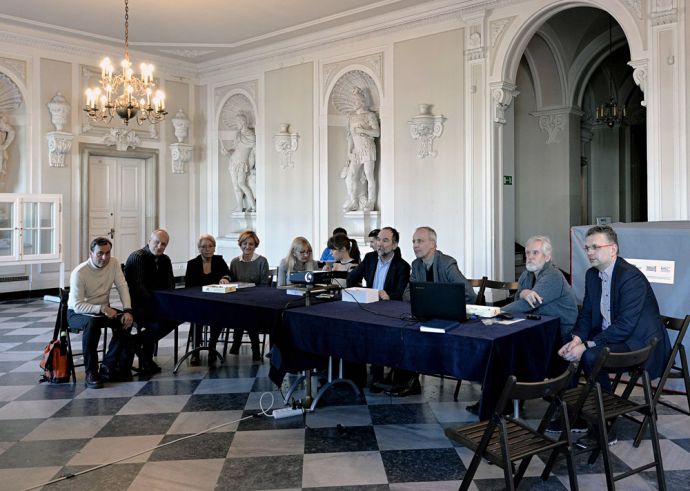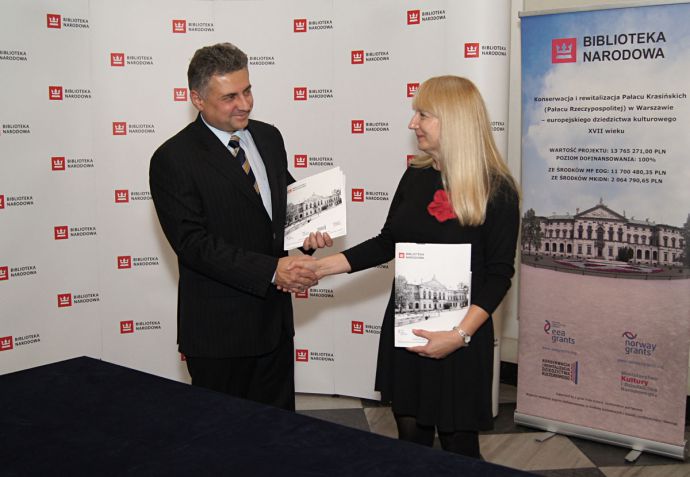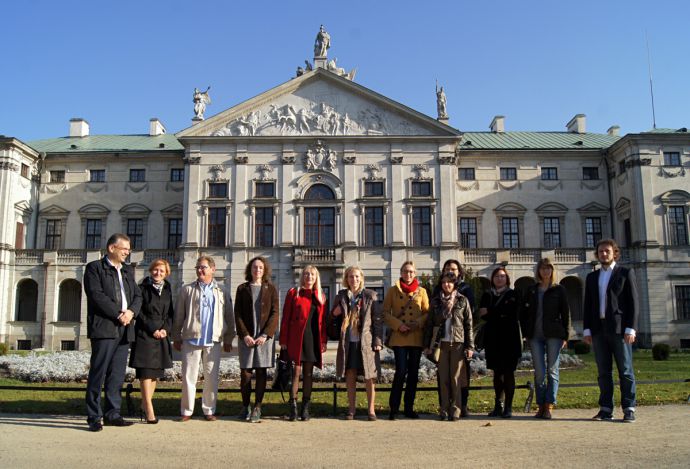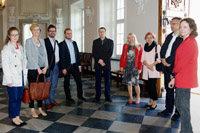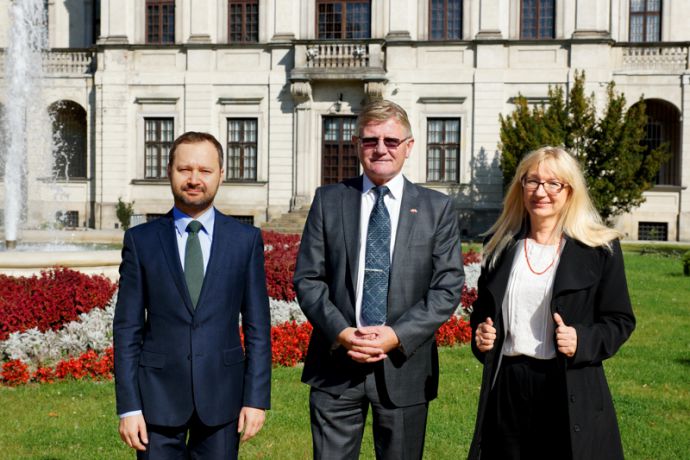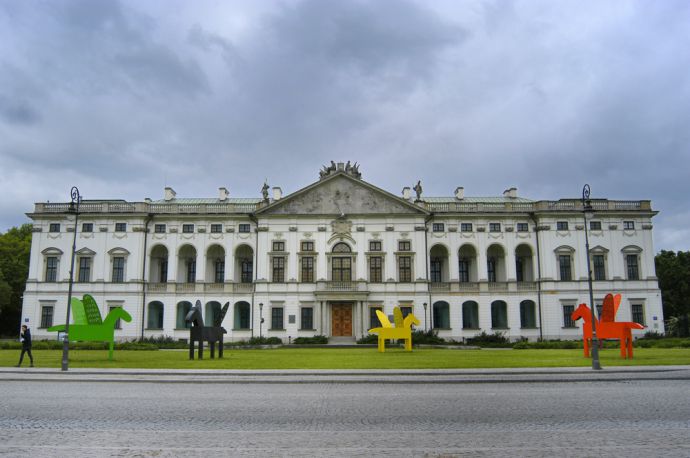Project news
74th anniversary of the Warsaw Uprising
Walking through the recently renovated Krasińskich square it is worth to stop for a moment to take a look at the Palace of the Commonwealth.
During the Warsaw Uprising the Palace was a defence point manned by the Parasol scouting battalion. On 27 August 1944, three German planes dropped bombs which turned the residence into ruin.
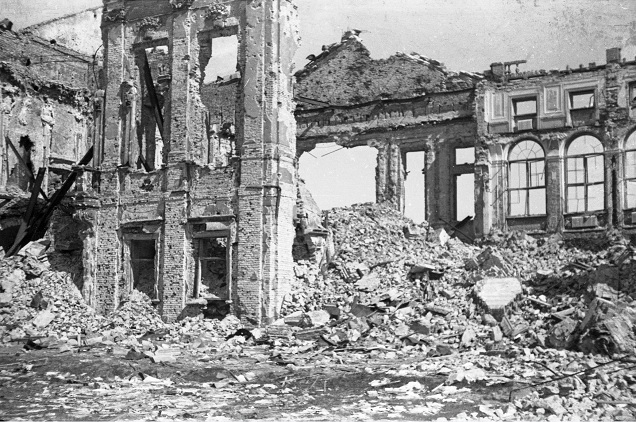 fot. www.batalionparasol.pl
fot. www.batalionparasol.pl
After being rebuilt in 1948–1961 the Palace was handed over to shelter the most valuable collections of the National Library, which survived the war.
Nowadays, after a through revitalization and conservation the Palace looks marvelous.
In its arcades we are presenting you some of the documents from the time of the Warsaw Uprising from the National Library's collection. Presented pictures, magazines, notices, orders and propaganda materials will allow you to feel the atmosphere of that horrible time.
90th anniversary of reactivation of the National Library. Ceremony with the participation of President Andrzej Duda
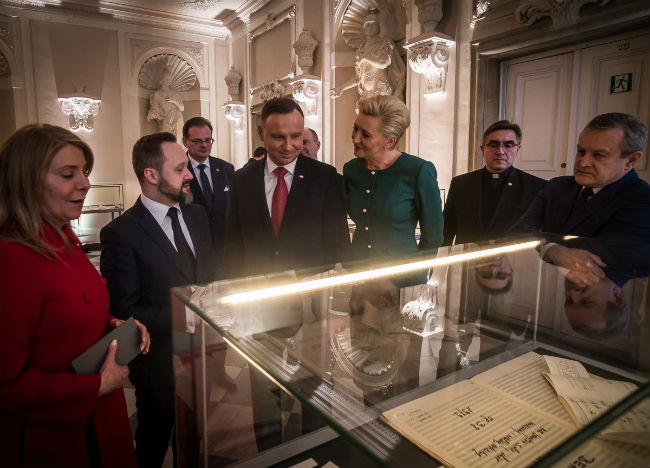
The ceremony commemorating the 90th anniversary of the signing by the President Ignacy Moscicki the Regulation on reactivation of the National Library was held on Monday, February 26 in the Palace of the Commonwealth.
Honorary guests were the President of the Republic of Poland Andrzej Duda together with the First Lady Agata Kornhauser-Duda and Professor Piotr Gliński, Deputy PM, Minister of Culture and National Heritage.
The Palace of the Commonwealth in TV
August 2017
Documentary about The Palace of the Commonwealth was broadcasted in the TVP 3 Warsaw show "Mazowiecki Globtroter" on Friday 4th August. The film has been prepared in cooperation with the National Library.
The documentary is available online on the TVP 3 Warsaw website.
The Patrimonium Project – Opening Conference
July 2017
On Friday 14th July the Opening Conference commence “The Patrimonium – digitization and sharing of Polish National Heritage from National Library and Jagiellonian Library collections “ took place in The Palace of The Commonwealth.
In the Palace arcades the conference posters were displayed on multimedia projection screens.
The Jan Kochanowski’s name Day
July 2017
The National Library’s literary picnic – The Jan Kochanowski’s name Day – took place in Krasińskich garden on Saturday 1st of July.
As usually, guests could participate in many attractions such as meetings with writers, poets, illustrators and actors. Additionally, everyone could join a poetic match, concert or dancing. Children could also participate in many attractions.
The promotion of the event was supported by posters which were displayed on the screens in arcades. After the nightfall, the atmosphere of the event was complemented by the new illumination on the renovated elevations of the Palace of Rzeczpospolita.
The renovation of elevation, illumination and system of multimedia screens are included in the project „Conservation and Revitalization of the Krasiński Palace (Palace of the Commonwealth) in Warsaw – European 17th century cultural heritage” which was co-financed by EEA Financial Mechanism and Norway Grants Programme.
Palace of the Commonwealth has regained its former splendour. Conference at the end of the revitalisation.
The Palace of the Commonwealth has finally regained its former splendour.
Immediately after the war, the hasty rebuilding from the damage suffered during the Warsaw Uprising did not fully meet either conservation or utility standards.
It was not until 2014 that conservation and revitalization, thanks to nearly PLN 14 million zlotys in funding from the EEA Financial Mechanism and Norway Grants Progaramme, allowed the restoration of the majesty of the building, considered to be the most beautiful palace north of the Alps, and to adapt it to new needs – also for the disabled.
On Monday, April 24, a conference was held which concluded the project. Ingrid Norstein, Advisor to the Embassy of the Kingdom of Norway; Karolina Tylus-Ow from the Ministry of Culture and National Heritage and Dr. Tomasz Makowski, Director of the National Library took part in the conference.
- Today we are celebrating the completion of the renovation of the façade of the Palace of the Commonwealth - said Director Tomasz Makowski - and also many improvements that allow this beautiful building to open wider for visitors. I would like to thank all who contributed to achieving such a great result. I hope that in the near future we will be able to renew the interior of the Palace too – emphasized the Director of the National Library.
Conservation and Revitalization of the Krasiński Palace (Palace of the Commonwealth) in Warsaw – European 17th century cultural heritage was granted almost PLN 14 million from EEA Financial Mechanism and Norway Grants as a result of the first call for proposals under the 2009–2014 Programme Conservation and Revitalization of National Heritage.
Of the 277 submitted applications submitted, the National Library project was ranked 5th.
- For more than 13 years, Norway has been supporting Poland in projects related to the conservation and renovation of its most valuable monuments - said Ingrid Norstein - I am very pleased that Poland benefits from these resources by supporting culture and heritage. This is how we give something not only at the moment, but we also leave a lasting impression on the future - stressed the representative of the Norwegian embassy.
Comprehensive renovation covered all the facades of the palace, stone carving elements, architectural details and stucco. On the top of the front tympanum a restored statue of Marcus Valerius Corvinus was placed. The works included also replacement of windows, which were designed so that the sun would not harm collections stored in the Palace. The window frames were restored to their original, bright colors, reproduced through iconographic documentation studies. Additionally, the front doors were renovated.
The building was adapted for use by the disabled through the installation of external and internal ramps and automatic doors and lifts.
Modern multimedia systems were installed, including an audiovisual installation in arcades and the system that illuminates all facades.
With the support of the Norwegian Funds, we have succeded to create a place which, while preserving its historical values, allows in its passages the functioning of a modern cultural institution open to the user.
The Book of Hours by Jakub Wargocki presented at the Palace of the Commonwealth
February 2017
The first presentation of the Book of Hours after this valuable renaissance manuscript has been bought at the London auction and brought back to Poland by the National Library with the financial assistance of the PZU Foundation, was held at the Palace of the Commonwealth on February the 3rd .
The ceremonial conference was honored by the presence of professor Piotr Gliński, Deputy Prime Minister and Minister of Culture and National Heritage.
The guests arriving at the conference could admire finely decorated pages of the manuscript on the multimedia screens located in the arcades of the Palace.
Such a spectacular exposition of the Book of Hours was possible thanks to the equipment and technology purchased under the “Conservation and revitalization of the Krasiński Palace (Palace of the Commonwealth) in Warsaw – European 17th century cultural heritage” project, co-financed with the funds from the EEA Financial Mechanism and Norwegian Financial Mechanism 2009–2014, as well as the domestic funds.
The screens, thoughtfully located in the glazed arcades, make it possible to present the unique elements of national heritage from the National Library collections to the public. This way, one of the main goals of the project, which is to make the Palace itself as well as its collections more available to the public, has been achieved.
Renovation works on the residential terraces of The Palace of the Commonwealth
January 2017
The renovation works start on the two open terraces symmetrically located above the arcades of the Palace from the side of Krasiński Garden.
An agreement concerning the above mentioned works was signed on the 27th of January between the National Library and Przedsiębiorstwo Konserwacji Zabytków MATEUSZ Sp. z o.o. Sp. K. – a contractor selected for this project. The works will be completed before the spring comes, meaning by mid April 2017.
The scope of work includes cleansing, biocidal and insulating treatment of the surfaces of the terraces.
Restored and secured terraces will be considered as a final achievement of the revitalization works conducted during the last few years in the Palace of the Commonwealth – a valuable and unique example of the baroque architecture.
The renovation may be carried out thanks to the additional funds received for the “Conservation and revitalization of the Krasiński Palace (Palace of the Commonwealth) in Warsaw – European 17th century cultural heritage” project.
The funds the National Library applied for, have been awarded within the frames of additional actions related to the “Conservation and Revitalization of the Cultural Heritage” programme supported by EEA Financial Mechanism and Norwegian Financial Mechanism for years 2009–2014.
The Palace of the Commonwealth is handicapped friendly
On 14 October 2016, the contractor for the construction works at the Palace of the Commonwealth – the Markbud company – completed its operations consisting in adapting palace spaces to the needs of people with disabilities.
For many years, the interiors of the Palace of the Commonwealth were not friendly for such people. However, significant changes have taken place recently. The Markbud company has submitted the final documentation of the work performed on adaptation of the palace interiors to the needs of the disabled to the ordering entity – the National Library. As a result of the work which took over six months a system helping the handicapped to move around in the building has been established: a lift in the northern part of the palace, a stair platform in the southern part, as well as stylishly designed restrooms in the basement that are friendly to the handicapped and people with small children. The alterations were possible thanks to the financial support from the 2009–2014 EEA Financial Mechanism and the domestic resources.
Let us remind that the work on adapting the palace to the needs of the disabled was started this spring. In the meantime, the tender proceedings took place for modern multimedia, which were delivered in August, a special application for multimedia content control was set up, the historical front doors were renovated. At a moment, several parallel operations were carried out in the palace. They were all completed on time and with stunning results. Additionally, despite the fact that intensive work was going on, the palace was opened for the public during special cultural events organized by the National Library: the Night of Museums, the First / the Oldest series, or John’s Name Day.
The alterations inside the building started a new stage in the history of the Palace of the Commonwealth in line with the directions of development of the National Library – a modern institution, open and friendly, catering for the needs of the visitor, without barriers. The implementation of those assumption is a success not only of the library, but also the Polish culture.
The work inside the Palace is making headway
6 September 2016
The summer has been exceptionally intensive inside the Palace of the Commonwealth due to stepped up modernization of its interiors.
Advanced efforts have been going on for several months now to adapt the Palace to the needs of visitors. A shaft was constructed in the northern part of the edifice and after an elevator is installed there it will be possible for persons with mobility problems to visit upper floors. The work on restroom remodelling is coming to a close, and preparations have begun for assembling a platform for the disabled in one of the interior passages. The historical front door has returned to its place after conservation. Electrical and cable networks have been adjusted to the needs of organizing cultural events, and a modern audio-visual system has been installed in the arcades.
The latter, which is made up of 8 large-scale video walls, will be used for presentations of the Palace and its history, the interiors, as well as the treasures of the Polish writing, which can be viewed, inter alia, in the ground-floor arcades. The ongoing improvements and the modern multimedia system stand for a totally new quality in the history of the Palace.
The above described modernization will change the functioning of the Palace of the Commonwealth. Thanks to the Norway Grants, a place has been created which – while retaining its architectural qualities and enchanting with its centuries long history – at the same time aims to meet the needs of the contemporary visitor.
Conservation of the front door at the Palace of the Commonwealth
July 2016
Because of the need to carry out conservation works the opulent front door of the Palace of the Commonwealth has left its prominent place for the first time in over sixty years.
It is known to everyone who at least once glanced at the Palace walking along the Krasiński Square. The huge, rectangular, richly ornamented door, which for decades has been guarding the entrance to the building, is opened only during major cultural events.
Lately, the door was taken down and transported to the conservation workshop, whence they will be returned to the palace in a few months. It was by no means an easy task. The massive oak wings weighing several hundred kilograms each had to be taken down by a team of workers. The photo gallery illustrated this unique operation.
The work on restoring the door to its original condition is necessary because it started to show visible signs of wear and tear. For the time of renovation, a replacement door was put in, which successfully imitate the original. We shall report on the progress of the conservation work soon.
The Palace of the Commonwealth at the Jan Kochanowski’s Name Day 2016
18 June 2016
The central figure of Jan Kochanowski’s Name Day in 2016 was Krzysztof Kamil Baczyński, whose more widely unknown artistic output could be admired at an exhibition organized at the Palace of the Commowealth.
Not everyone is aware that Karzysztof Kamil Baczyński, known mainly for his poetry depicting the horrors of the Nazi occupation, was also an author of beautiful love poems and dreamt of being an illustrator. The amazing drawings as well as the manuscripts of poems saved by his mother could be seen in the Knights’ Hall of the Palace displayed in cabinets bought from Norway Grants.
For the first time Jan’s Name Day was celebrated against the background of the revitalized facades of the Palace. The walls of the Palace, which have been renovated thanks to Norway Grants, have provided an unforgettable setting for this year’s celebrations.
On Jan’s Name Day, the Palace offered also other attractions. In the evening, in the Caryatid Hall, a performance based on short stories of Toon Tellegen – a Dutch master of the absurd and philosophical contemplation – Everyone Else's Birthday was shown for the youngest participants, and after dusk the guests could admire the fantastic illumination on the western facade of the building.
We would like to invite you to visit the gallery of photos from that event.
Modern multimedia solutions in the palace are a step closer
1 June 2016
On Wednesday, 1 June 2016, an agreement for the purchase and installation of audio-visual equipment in the arcades of the Palace of the Commonwealth was signed at the National Library.
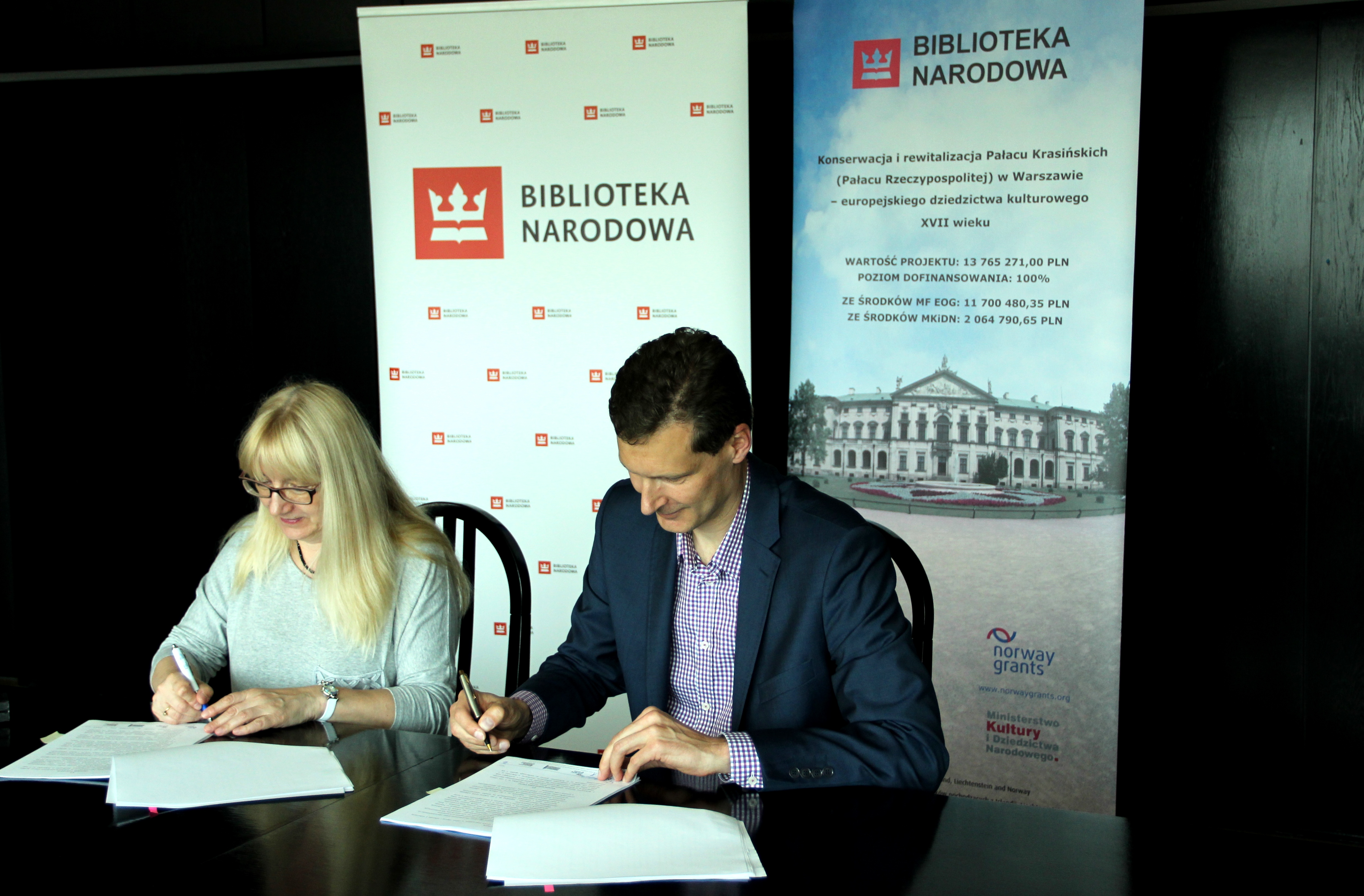
The agreement was signed between the National Library, represented by Grażyna Spiechowicz-Kristensen – Deputy Director of the Library, and TRIAS Sp. z o.o., which was represented by Piotr Żerko, President of the Board.
The purchase of displays is an investment which will dramatically change the image of the Palace, which is today practically excluded from the tourist traffic because of its special functions. One of the assumptions for The Conservation and revitalization of the Krasiński Palace (Palace of the Commonwealth) in Warsaw – European 17th century cultural heritage project is to create conditions for the dissemination of knowledge about the present function of the Palace housing the Special Collections of the National Library as well as its research, educational and popularizing activities.
The displays will be used to present the history of the Palace and the priceless collections that are housed therein. The audio-visual installation in the Palace’s arcades will provide access to special collections for tourists and Warsaw inhabitants, including the disabled persons. The installation will also allow a multimedia presentation of the collections in the exhibition rooms inside the Palace.
The Palace of the Commonwealth – pictures of a remarkable renovation
May 2016
Over the past year, the Palace of the Commonwealth underwent a thorough metamorphosis which has restored its original glamour. The comprehensive revitalization of the edifice and its adaptation for the needs of both people working in the Palace as well as its users was an enormous and complicated operation, and at the same time a unique experience for all those involved in the project of renovation of this exceptional place.
We would like to show you what has been done to date. We are presenting a gallery of photos documenting the magnificent transformation which was started in 2014 and has been going on since. Soon, following the progress of works in the building, we shall show subsequent shots.
The revitalization project will be finished in 2016, but already today it can be ascertained that thanks to Norway Grants the Palace of the Commonwealth has gotten back its former splendour and the well-deserved title of one of the most beautiful objects of Polish Baroque architecture again arousing the same admiration as it did when it was built.
Let’s have a look at the pictures of that unusual metamorphosis.
The Night of Museums in the Palace of the Commonwealth
14 May 2016
For the first time in the history of the Night of Museums, the Palace of the Commonwealth was opened to the public and right away aroused great interest of the participants in that event. Until Saturday midnight, 14 May, the exceptional interiors were seen by over 1500 visitors.
Special illumination on the renovated façade of the building invited people for a tour and contributed to a large turnout. Inside, the visitors admired, among other things, the treasures of Polish writing presented within the series The First/The Oldest – The Statutes of Casimir the Great – a set of the first statutes in the history of Polish law-making.
Soon, the palatial interiors will be fully accessible also for the disabled – at present, the advanced works are underway in one of the wings on the assembly of a lift, whereas at the southern entrance to the building a special ramp for whom climbing the stairs is a problem has been installed under the project “Conservation and revitalization of the Krasiński Palace (Palace of the Commonwealth) in Warsaw – European 17th century cultural heritage” financed with Norway Grants.
The Palace is being adapted to the needs of the present with its exquisite architectural values remaining intact. Come and see that exceptional transformation for yourself.
In the Palace about the Palace
14 April 2016
On 18 April 2016, at 11 a.m., the National Library organizes in the Palace of the Commonwealth a conservation session entitled “CONSERVATION IN THE PALACE – CONSERVATION OF PALACES” and a special presentation of how old prints and manuscripts are conserved at the National Library.
PROGRAMME
11.00 a.m. presentation of how old prints and manuscripts are conserved
11.30 a.m. Bogdan Filip Zerek – Relocation of the iconographic collection due to water activity on the wall of the storage
12.00 a.m. Bartosz Szymański – Preventive conservation at the Conservation Studio of Library Collections as compared with modern trends in conservation of cultural heritage
1.30 p.a. Agata Lipińska –Miłosz’s shirt, Hłasko’s sheepskin coat, Komeda’s watch. Three-dimensional collections in the Manuscript Department of the National Library
13.00 p.m. Bogdan Filip Zerek – Renovation of library storage rooms without moving out the collection.
1.30 p.m. Roland Róg – Comprehensive renovation of the Myślewicki Palace in the Warsaw Łazienki Royal Gardens
2.00 p.m. Paweł Jędrzejczyk – History and renovation of the Palace at Helenów near Pruszków
3.00 p.m. Piotr Grzegorz Mądrach – Renowation works at the Krasiński Palace – Palace of the Commonwealth in Warsaw
3.30 p.m. Leszek Kuszewski – Teknos in national heritage
4.00 p.m. A film show on the renovation of the Krasiński Palace (Palace of the Commonwealth) – the seat of the National Library in Warsaw
The organizers of the twentieth edition of the Conservation Art – Conservation Meetings include: Art Conservation Section of the Warsaw Chapter of the Association of Polish Artists and Designers, State Archaeological Museum in Warsaw, Museum of Technology and Industry in Warsaw, Polish Chamber of Art Conservators. This group also included the National Library which carried out the project: “Conservation and revitalization of the Krasiński Palace (Palace of the Commonwealth) in Warsaw – European 17th century cultural heritage” project financed with Norway Grants and EEC Funds.
In connection with the anniversary edition of the Conservation Art the organizers planned a number of meetings and proclaimed the month of April 2016 THE MONTH OF CULTURAL HERITAGE CONSERVATORS in Warsaw. More information on accompanying events may be found here.
The night the lights went on for the first time
22 March 2016
At 6.30 p.m. on 19 March 2016, the lights illuminating the façade of the Palace installed as part of the “Conservation and revitalization of the Krasiński Palace (Palace of the Commonwealth) in Warsaw – European 17th century cultural heritage” project went on for the first time.
During the show, the stories presented on the tympanum, on that night so perfectly lit for the first time, were told to the audience gathered in front of the Palace by a licenced city guide. Martyna Marcinkowska from the National Library stressed the exceptionality of the ceremony – on that night the National Library not only initiated the illumination, but for the first time would take part in the “Earth Hour” event. As a result of the worldwide environmental campaign, the lights will be switched off between 8.30 and 9.30 p.m., and the Krasiński Palace will join such buildings as the Presidential Palace, Prime Minister's Chancellery, Royal Castle, National Stadium or Grand Theatre, which have been taking part in the campaign for years.
Construction and assembly work contract signed
16 March 2016
On Tuesday, 15 March 2016, a contract for the adaptation of the interiors of the Palace to the needs of the disabled was signed at the National Library. The contractor is the MARKBUD company selected by tender.
The National Library was represented by its Deputy Director Grażyna Spiechowicz–Kristensen, and the contractor by the Company President Marek Krajewski.
The contract covers comprehensive construction and assembly operations, such as:
- fitting of a lift shaft in the existing structure of the building (levels -1, 0, +1, +2) including the installation and putting in operation of a passenger lift to be used by the disabled,
- carrying out of construction and installation works including assembly of a platform for the disabled,
- carrying out of construction and installation works to adapt rest rooms to be accessible to all at -1 level.
Site handover to the Contractor is scheduled for Monday, 21 March 2016. The work is scheduled to be finished by 31 August 2016.
The gem of Baroque architecture in its full glamour!
14 March 2016
On Saturday, 19 March 2016, at 6.30 p.m., the Palace of the Republic shall reveal its new glamour.
The entire building will be illuminated, emphasizing the architectural details of the recently completed renovation of all four facades of the building. The minutest details of the ornamentation of both tympanums will be showed off, in particular the exquisite sculptures carved by Andreas Schlüter. The illumination will be of the floodlight type emphasizing the vertical and horizontal divisions of the facades, cornices and window ledges, which will sallow to show the Palace as a homogeneous form inscribed in the history of the capital. Henceforth the Palace will be illuminated every night from dusk till dawn.
The illumination is a subsequent state of work on the “Conservation and revitalization of the Krasiński Palace (Palace of the Commonwealth) in Warsaw – European 17th century cultural heritage” project financed with Norway Grants and EEC Funds. The project was started in 2014 and its completion is planned for December 2016.
The design of the automatically switched, energy saving illumination complies with the guidelines of the Warsaw Conservator of Architectural Heritage.
Launch of the book: The Road North. The Anthology of Norwegian Non-Fiction Literature
1 March 2016
The National Library, the KARTA Centre and the Royal Norwegian Embassy in Warsaw would like to invite you to attend the launch of the book Droga na Północ. Antologia norweskiej literatury faktu (The Road North. The Anthology of Norwegian Non-Fiction Literature). The meeting, attended by His Excellency Karsten Klepsvik, Ambassador of the Kingdom of Norway to Poland, and Zbigniew Gluza, President of the KARTA Centre, will be held on Thursday, 3 March 2016, at 6 p.m. in the Palace of the Republic.
Questions will be answered by:
Professor Lech Sokół – Ambassador of the Republic of Poland to Norway 1991–1996
and the book’s authors:
Agnieszka Knyt (editor, author of many publications on the history of the 20th century), and
Paweł Urbanik (specialist in Scandinavian studies, translator of Norwegian literature, researcher at Oslo University)
The meeting will be moderated by Justyna Czechowska (translator, organizer of cultural events).
Excerpts from the book will be read by Katarzyna Herman.
Jan Długosz’s Catalogue of the Archbishops of Gniezno on display
27 February 2016
On 27 February 2016, as part of the series of THE FIRST/THE OLDEST, the National Library displayed the most beautiful book of the Polish Renaissance, Jana Długosz’s Catalogue of the Archbishops of Gniezno (Catalogus archiepiscoporum Gnesnensium) illuminated by Stanisław Samostrzelnik. The display of the treasure was accompanied by an exhibition, a lecture and a discussion of art historian on the most interesting artistic and historical issues connected with the Catalogue. An additional attraction was – already turned into a tradition – a guided tour of the Palace.
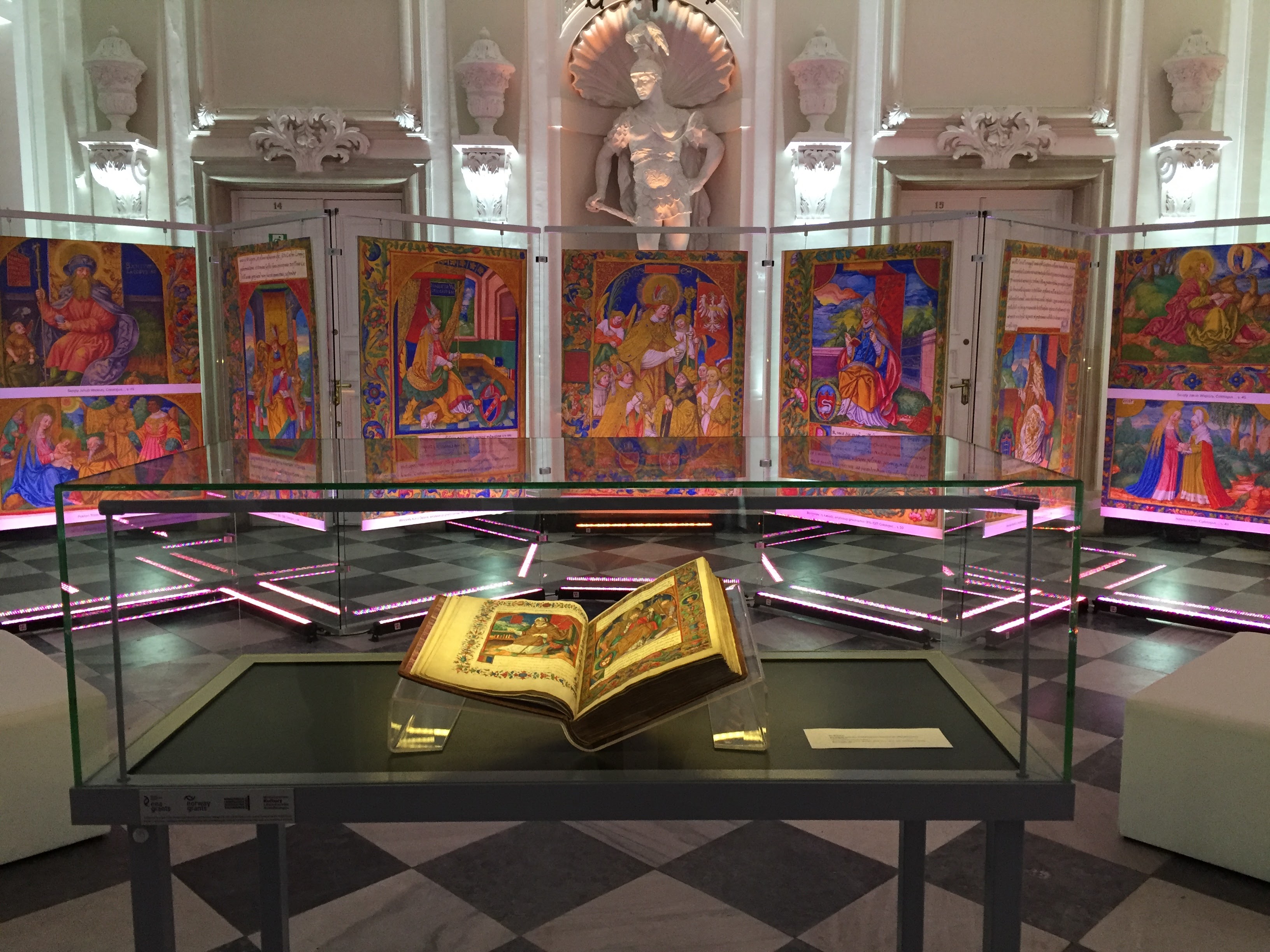
A film about the Palace
8 February 2016
On 1 March 2014, the National Library initiated the “Conservation and revitalization of the Krasiński Palace (Palace of the Commonwealth) in Warsaw – European 17th century cultural heritage” project. Today, we are halfway through the implementation of the planned operations the completion of which is scheduled for the latter half of 2016. We would like to invite you to watch a film documenting what has been done so far.
Tyniec Sacramentarium presentation
1 December 2015
On 28 November, in the Palace of the Commonwealth, the National Library organized a subsequent event of the THE FIRST/THE OLDEST series. This time, the Tyniec Sacramentarium was displayed.
This richly ornamented code is not only one of the oldest (11th century) manuscripts kept in Poland, but also an intriguing source of knowledge about the culture of the Piast rule. The event was accompanied by lectures: on women and books in the 11th century, and on the beginnings of the Benedictine Abbey in Tyniec.
THE FIRST/THE OLDEST is a series of presentations to celebrate the 1050th anniversary of Christianity in Poland. Every month, the National Library is going to put on display in the Palace of the Commonwealth the first texts and the oldest relics of culture and history documenting the beginning of the Polish State.
Thanks to modern cabinets bought under the Project the most valuable treasures of the National Library may be safely presented to the public at large.
Włodek Pawlik’s music manuscripts in National Library
26 November 2015
On 26 November 2015, the ceremony of handing over Włodek Pawlik’s music manuscripts to the National Library collections was held at the Palace of the Commonwealth.
Włodek Pawlik – composer, jazz pianist, winner of the Grammy 2014 award – donated nine scorebooks with drafts of his compositions to the National Library. Three of them contain film music manuscripts (Rewers and Within the Whirlwind). One comprises a draft of the 2nd piano concerto composed by the artist, and the rest – music to the poetry of outstanding Polish poets: Jarosław Iwaszkiewicz (Struny Na Ziemi, 2011), Czesław Miłosz (Miłosz Jazz Project, 2011) and Józef Czechowicz (musical show Wieczorem, 2013). The donated archive was displayed in cabinets bought under the Project.
The ceremony was highlighted by a short performance by the artist.
The next stage of revitalization works
30 October 2015
On 28 October 2015, a new agreement was signed between the National Library and the general contractor Przedsiębiorstwo Konserwacji Zabytków MATEUSZ Sp. z o.o. Sp. K.
The agreement provides for the replacement of outside and insider door frames (on the southern side). This operation is aimed at adaptation of the entrance to the Palace for the disabled.
The subsequent works under the agreement will include de-icing installation on the roof and glazing of the arcades on the side of the garden. With the support of the Public Land Agency the National Library also obtained the consent of the Warsaw Conservator of Historical Relics for revalorization of the area surrounding walls with steps at the access road to the Palace and installation of external lights – architectural illumination. Those work will complete the current stage of revitalization and renovation of the Krasiński Palace/Palace of the Commonwealth, which was started in November 2014.
Open day
26 October 2015
On 24 October 2015, an open day was held at the Palace of the Commonwealth (Krasiński Palace) in Warsaw. The National Library had prepared guided tours and a special display of manuscripts and old prints dedicated to Norway, Iceland and Lichtenstein.
The doors of the Palace were opened at 10 a.m. It was the that time that the first of five tours led by a licenced city guide specially employed for this occasion. The guide showed the visitors the meticulously restored facades and the renovated sculptural ornaments of both tympanums. In the interiors of the Baroque Palace, he outlined its history and major changes planned under the Project.
Throughout the day, in the Knight’s Hall, visitors could see the collection of manuscripts and old prints dedicated to the countries which are contributors to the EEA Financial Mechanism and Norway Grants. The National Library had selected objects of special cultural and editorial significance. The display also included Stanisław Przybyszewski’s “At Malstromm” (a manuscript written by Dagny Juel, Przybyszewski’s wife). All objects were displayed in cabinets bought under the Project.
Visitors could also see the Wilanów Library. It is a historical 18th-century collection of books placed in original 19th-century furniture.
On that day the Palace was visited by over 1,600 people. The Open Day confirmed that the Krasiński Palace (Palace of the Commonwealth) is an important spot on the map of Warsaw historical monuments. It also showed that the Palace might also perform educational functions for the public at large.
Open day
13 October 2015
The unique opportunity to see the Palace inside. Guided tours, a special presentation of manuscripts and old prints from the collections of the National Library and an afternoon in the Caryatid Hall with a view onto the Krasiński Gardens. Please come and enjoy the Open Day from 10 a.m. to 7 p.m.
The Saturday of 24 October 2015 will be an exceptional day in the life of the Palace of the Commonwealth. On a day-to-day basis, the 17th-century Palace serves the mundane purpose of a storehouse – it is a place where the oldest and most valuable Polish prints are kept. But on 24 October you will be able to have a closer look, listen to its history and visit the room where the historical 18th-century book collection of the Potocki and Branicki family is kept on original furniture.
There will be guided tours: at 10 a.m., 11 a.m., 12 noon, 2 p.m. and 3 p.m.
Throughout the day, in the Knights Hall, visitors will be able to see a specially selected collection of old prints devoted to Scandinavia (including the Latin and German version of "Edda" and Olaf Magnus’ "The Story of North People") and a collection of manuscripts, e.g. Stanisław Przybyszewski’s "At Malstromm" (a manuscript written by Dagny Juel, Przybyszewski’s wife), or Władysław Reymont’s "Dola" (Fate), Henryk Sienkiewicz’s "Wyrok Zeusa" (Zeus’ Verdict), as well as Czesław Miłosz’s "Notes warsztatowy" (The Workshop Notebook) and Wisława Szymborska’s "Wyklejanki" (Collages).
The open day is also a special occasion since the Palace is now being renovated. For this reason the second floor could be seen in daylight which is normally banned from there – specially shaded windows protect the most valuable prints against destructive UV rays. That day, however, we shall let some sunshine in and shall enter the Caryatid Hall with unshaded windows overlooking the Krasiński Gardens, just like during the times of the founder of the Palace – Jan Dobrogost Krasiński.
Mission: Windows
24 September 2015
The first picture depicting the colours of the facade of the Palace of the Commonwealth is a painting by Canaletto. The oil represents the eastern and northern facade of the building in sharply contrasting light.
The Palace of the Commonwealth in the Krasiński Gardens has been rebuilt and renovated several times. In the late 17th century, the building burned down, and during the 1944 Warsaw Uprising it was almost totally destroyed again. The oldest illustrations depicting the Palace are black-and-white drawings. - The first picture which gives us an idea of the colours of its facade is Canaletto's painting - says Piotr Grzegorz Mądrach, a conservator collaborating with the National Library. The oil, which may be seen at the Royal Castle in Warsaw, represents the eastern and northern facade of the building in a sharply contrasting light. In this picture it may be seen that the north side window is in natural oak. On the other hand, the eastern windows are very dark. That side of the building is shown in a very deep shadow; hence, the colour may seem to be darker that it was in reality.
In turn, the 18th century iconographic documentation very clearly depicts white coloured shutters. We know, however, that in the latter part of the 19th century window frames were replaced with new ones or renovated. As a result of that operation the colour of window frames was changed to a dark one. Since the original frames, as well as the later ones that we know from Canaletto’s painting had been irretrievably lost, their original colour turned out to be a true riddle.
- During the reconstruction of the Palace of the Commonwealth after World War II, probably following the suggestion of the dark windows in Canaletto’s painting, it was decided to paint them dark brown – – says Mądrach – This is by no means documented at all; the blueprint pieces that have remained from the reconstruction period do no mention any colour selection.
The problem of the colour of the Palace’s facade returned in connection with the conservation and revitalization project. Window replacement was started in July. According to the initial concept dark-brown windows were to be replaced with windows of the same colour. It was opposed by the conservator. A special conservation committee had been set up to determine the correct colour of window frames, which – having analyzed all preserved images of the Palace – has recommended white. The final decision was made by the Conservation Office in Warsaw by selecting grey-green.
188 windows are to be replaced. Each window has been designed to a special order of the National Library. In the rooms where manuscripts and early printed books are kept window panes will be tinted so as to prevent the harmful effect of sunrays. The work will be most probably finished by the end of September.
Renovation of the front facade of the Palace
31 August 2015
A contract for complementary renovation works on the front facade of the Palace of the Commonwealth in Warsaw was signed on Thursday, 27 August 2015. This is part of the “Conservation and revitalization of the Krasiński Palace (Palace of the Commonwealth) in Warsaw – European 17th century cultural heritage” Project.
The renovation of the front facade of the Palace in 2008 was financed with funds from the Ministry of Culture and National Heritage and private investors. Initially, only the facades which had not been renovated since the post-war reconstruction of the Palace were included in the Revitalization Project. The contract of 27 August 2015 is possible to be carried out following the consent of the Programme Operator, i.e. the Ministry of Culture and National Heritage for extending the material scope of the Project owing to savings generated in the course of its implementation. The general contractor of the renovation works, Przedsiębiorstwo Konserwacji Zabytków Mateusz sp. z o.o. sp. K., plans to complete the operation by 31 March 2016.
The 71st anniversary of the destruction of the Palace of the Commonwealth
27 August 2015
August of 1944 was the most bloody and tragic month in the history of the Palace of the Commonwealth. On the second day of the Warsaw Uprising the building was captured by the Home Army, and later became the headquarters of the “Parasol” (Umbrella) battalion, and a field hospital was arranged in its basement. The Palace was under gunfire for 25 days. On the 26th day, the Nazis dropped delayed fuse bombs, which almost completely destroyed the building.
The Palace was reconstructed after the war, and today – thanks to the funds from the EEA Financial Mechanism and Norwegian Financial Mechanism, as well as the domestic funds – it is undergoing complete renovation.
See the collection in the Polona Digital Library
Marcus Valerius is back on the tympanum of the Palace of the Commonwealth
19 June 2015
After thorough conservation the sculpture representing Marcus Valerius aka Corvinus (Raven) has been returned to the top of the tympanum on the Palace of the Com monwealth. The Krasińskis, who founded the Palace, considered that Roman general to have been the legendary ancestor of their family, connecting his agnomen with their coat-of-arms (Ślepowron).
The work had been started with a detailed conservation survey and documentation. Then, damaged fragments were repaired and restored, the stone of which the sculpture is made was proofed, at the same time making the colour of the reconstructed fragments match the original. Special anti-shock insulation was put between the pedestal and the base to prevent cracking in the future.
The renovation was done by Paweł Pietrusiński’s Pracownia Rzeźby “Bieniewo” (Bieniewo Sculpting Studio).
The construction and conservation works at the Palace of the Commonwealth have started
10 April 2015
The coming of spring made it possible to start work on the outside of the Palace of the Commonwealth.
Having fenced in the area and putting up the scaffolding, the contractor started the construction and conservation works.
The ceremony of handing over Franciszka and Stefan Themerson’s archives
29 January 2015
On Wednesday, 28 January 2015, the ceremony of handing over to the National Library of Franciszka and Stefan Themerson’s archives was held at the Palace of the Commonwealth with the participation of Prof. Małgorzata Omilanowska, Minister of Culture and National Heritage, and Dr. Tomasz Makowski, Director General of the National Library.
The materials, which include numerous manuscripts, photographs, letters, notes, graphics, documents, and even such objects as a typewriter, a photographic camera or engraving blocks, were put on display in new cabinets purchased under the “Conservation and revitalization of the Krasiński Palace (Palace of the Commonwealth) in Warsaw – European 17th century cultural heritage” Project, co-financed with the funds of the 2009–2014 EEA Financial Mechanism .
The ceremony of handing over the Themersons archives and the accompanying exposition of selected collections constitute an example of the realization of an objective the National Library committed itself to carry out under the Project. Thanks to the use of the newly purchased cabinets the range of organized cultural and educational events has been enriched with the possibility of displaying the collections of museum and historical value kept at the Palace.
A working meeting
17 January 2015
On February, 16 January 2015, a working meeting was held to discuss changes to be introduced to the window frame replacement project.
On the part of the Warsaw Historical Monuments Conservation Office the meetings was attended by: Piotr Brabander – Director of the Warsaw Historical Monuments Conservation Office; Karol Guttmejer and Dominika Szewczykiewicz. The National Library was represented by: Grażyna Spiechowicz–Kristensen, Director for Administrative and Technical Affairs and members of the Project Office.
On the basis of a presented model window the meetings discussed structural solutions as well as the colour scheme of window frames to be applied during their replacement.
The works are scheduled to include: dismantling of existing window frames, concrete internal window sills, and putting in newly designed frames and marble window sills. The cost of window replacement accounts for nearly 40% of total expenditure planned under the project.
Completion of archaeological research
7 January 2015
Archaeological research has been carried out as part of the Palace conservation and revitalization project. It was performed by a group of five archaeologists under the direction of Mr. Andrzej Gołembnik.
See presentation of results of archaeological research
The research covered an area of 34 sq. m. It included three excavations at the gable walls of the Palace: two on the south side and one on the north side. The research revealed that remnants of historical layers had been preserved on small areas, which confirm the suburban nature of the settlement preceding construction of the Palace. At the same time as archaeological research, detailed documentation of the edifice was performed with the use of latest technologies, such as 3D laser scanning as well as aerial and ground digital photogrammetry. All recordings were geodetically positioned thus connecting the contents of archaeological layers recorded in excavations with the mass of the Palace.
Signing of a contract for the construction and conservation work
7 November 2014
On Friday, November 7, at the Palace of the Commonwealth, a contract was signed for the construction, conservation, installation works as well as arrangement and repair of the grounds and the greenery within the framework of the task entitled: “Conservation and revitalization of the Krasiński Palace (Palace of the Commonwealth) in Warsaw – European 17th century cultural heritage”, co-financed by the EEA Financial Mechanism and domestic funds. The general contractor is Przedsiębiorstwo Konserwacji Zabytków Mateusz Sp. z o.o. Sp.K. which has been selected by tender.
The National Library was represented by Grażyna Spiechowicz–Kristensen – Director for Administrative and Technical Affairs, and the contractor by Dariusz Bojko – President of the Management Board of the Mateusz company.
Site handover to the Contractor is scheduled for Monday, November 17. The work is scheduled to be finished by 31 March 2016.
A delegation of the Financial Department of the Ministry of Culture and National Heritage visits the Palace of the Commonwealth
5 November 2014
On Wednesday, November 5, the Palace of the Commonwealth was visited by representatives of the Financial Department of the Ministry of Culture and National Heritage – the operator of the Conservation and Revitalization of National Heritage programme within the framework of which the Palace is renovated.
The delegation included, among other persons: Head of the Department Ewa Pawlik and Ryszard Czyżewski – project controller. The National Library was represented by: Grażyna Spiechowicz–Kristensen – Director for Administrative and Technical Affairs, Artur Galiński – Head of the Investments and Repairs Division, Aneta Podgórska-Adamowicz – project coordinator and Marcin Jaworowicz, head of the Organizational Secretariat.
The visit was dedicated to discussing issues connected with extent of planned construction and conservation works to be financed with the grant. The delegation also toured the Palace and saw a presentation of selected major collections of the National Library.
A delegation of the European Funds Department of the Ministry of Culture and National Heritage visits the Palace of the Commonwealth
13 October 2014
On Friday, 10 October, the Palace of the Commonwealth was visited by a delegation of the European Funds Department of the Ministry of Culture and National Heritage – the Operator of the Conservation and Revitalization of Cultural Heritage Programme within the framework of which the Project of conservation and revitalization of the Palace is financed from Norway Grants.
The meeting was attended by: Monika Krzyżanowska-Piróg, division head at the EFD; Piotr Giemza, Project Manager, and a group of employees of the Department. The National Library was represented by: Grażyna Spiechowicz–Kristensen, Director for Administrative and Technical Affairs; Artur Galiński, head of the Investment and Maintenance Division, and Aneta Podgórska-Adamowicz, Project Coordinator.
Issues relating to the planned scope of work were discussed at the meeting. The guests were also acquainted with the history of the 17th-century Palace and saw some of the most valuable special collections of the National Library, among other things first editions of Nicolaus Copernicus and Jan Kochanowski, as well as manuscripts of Zbigniew Herbert, Tadeusz Różewicz and Wisława Szymborska.
Ambassador of Norway visits the Palace of the Commonwealth
25 September 2014
On Wednesday, September 24, the Ambassador of Norway, Karsten Klepsvik, visited the Palace of the Commonwealth. The National Library was represented by Tomasz Makowski, PhD, Director General of the Library, and Grażyna Spiechowicz-Kristensen, Director for Administrative and Technical Affairs. The visit was connected with the financing received by the Library under Norway Grants for the renovation of the Palace of the Commonwealth.
During the visit the history of the 17th century Palace was presented and issues relating to the scope of planned renovation works were discussed. Of particular interest to the Ambassador was the wartime fate of the Palace and Library collections. The visit ended with a special display of valuable pieces from National Library collections.
The 17th-century Palace will become even more beautiful
16 July 2014
The National Library has started a major refurbishment of the Krasiński Palace (aka Palace of the Commonwealth). Almost 14 million zlotys acquired from Norway Grants will be in the first place spent on renovation of the facades and restoration of all superb sculptures adorning the edifice. It is also planned to invigorate the arcades by installing multimedia screens which will be used to present virtual exhibitions and the most valuable collections now locked away in NL’s vault.
After the completion of those works, it is planned to do a complete renovation of Palace’s interiors. The inaugural press conference – attended by Prof. Małgorzata Omilanowska, Polish Minister of Culture and National Heritage, Anne Grete Riise, chargé d'affaires at the Royal Norwegian Embassy in Warsaw, dr. Tomasz Makowski, Director of the National Library – was held on 16 July 2014.
The National Library received a 100% grant in the amount of PLN 13,765,271.00 for the implementation of the project »Conservation and Revitalization of the Krasiński Palace (Palace of the Commonwealth) in Warsaw – European 17th century cultural heritage«. The financing has been awarded under the first call for proposals under the 2009–2014 Programme Conservation and Revitalization of National Heritage of the EEA Financial Mechanism and Norway Grants announced by the Ministry of Culture and National Heritage. On 9 May 2014, the Financial Agreement no. 5/2014/PL08/EEA MF with the Ministry which set the contributions as follows: 85% of the funds will be awarded from the EEA Financial Mechanism (PLN 11,700,480.35) and 15% by the Ministry of Culture and National Heritage (PLN 2,064,790.65). 277 applications were received for the Programme, of which only 18 received financing. The National Library ranked fifth on the list of supported projects.




